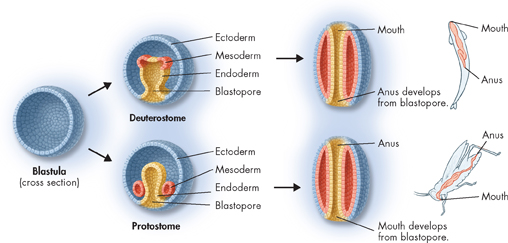
FIGURE 25–9 Blastula and Blastopore Formation During the early development of an animal embryo, a hollow ball of cells called a blastula forms. An opening called a blastopore forms in this ball. In deuterostomes, such as fishes, the blastopore forms an anus. In protostomes, such as grasshoppers, the blastopore develops into the mouth.
Patterns of Embryological Development Every animal that reproduces sexually begins life as a zygote, or fertilized egg. As the zygote begins to develop, it forms a blastula (BLAS tyoo luh), a hollow ball of cells like an inflated balloon. As the blastula develops, it folds in on itself, as if you were holding the balloon and pushing your thumbs toward the center. This folding changes a ball of cells into an elongated structure with a tube that runs from one end to the other. This tube becomes the digestive tract, as shown in Figure 25–9.
At first, this digestive tract has only a single opening to the outside, called a blastopore. An efficient digestive tract, however, needs two openings: a mouth through which food enters and an anus through which wastes leave. In phyla that are protostomes (PROH tuh stohms), the blastopore becomes the mouth. In protostomes, including most invertebrates, the anus develops at the opposite end of the tube. In phyla that are deuterostomes (DOO tur uh stohms), the blastopore becomes the anus, and the mouth is formed from the second opening that develops. Chordates and echinoderms are deuterostomes. This similarity in development is one of several characteristics that indicate that echinoderms are closely related to chordates.
Segmentation: Repeating Parts As many bilaterally symmetrical animals develop, their bodies become divided into numerous repeated parts, or segments. These animals are said to exhibit segmentation. Segmented animals, such as worms, insects, and vertebrates, typically have at least some internal and external body parts that repeat on each side of the body. Bilateral symmetry and segmentation are found together in many of the most successful animal groups.
Segmentation has been important in animal evolution because of the way genes control the production and growth of body segments. If an organism has segmentation, simple mutations can cause changes in the number of body segments. Different segments can also become specialized, such as having a head or specialized limbs.

Table of Contents
- Formulas and Equations
- Applying Formulas and Equations
- Mean, Median, and Mode
- Estimation
- Using Measurements in Calculations
- Effects of Measurement Errors
- Accuracy
- Precision
- Comparing Accuracy and Precision
- Significant Figures
- Calculating With Significant Figures
- Scientific Notation
- Calculating With Scientific Notation
- Dimensional Analysis
- Applying Dimensional Analysis




